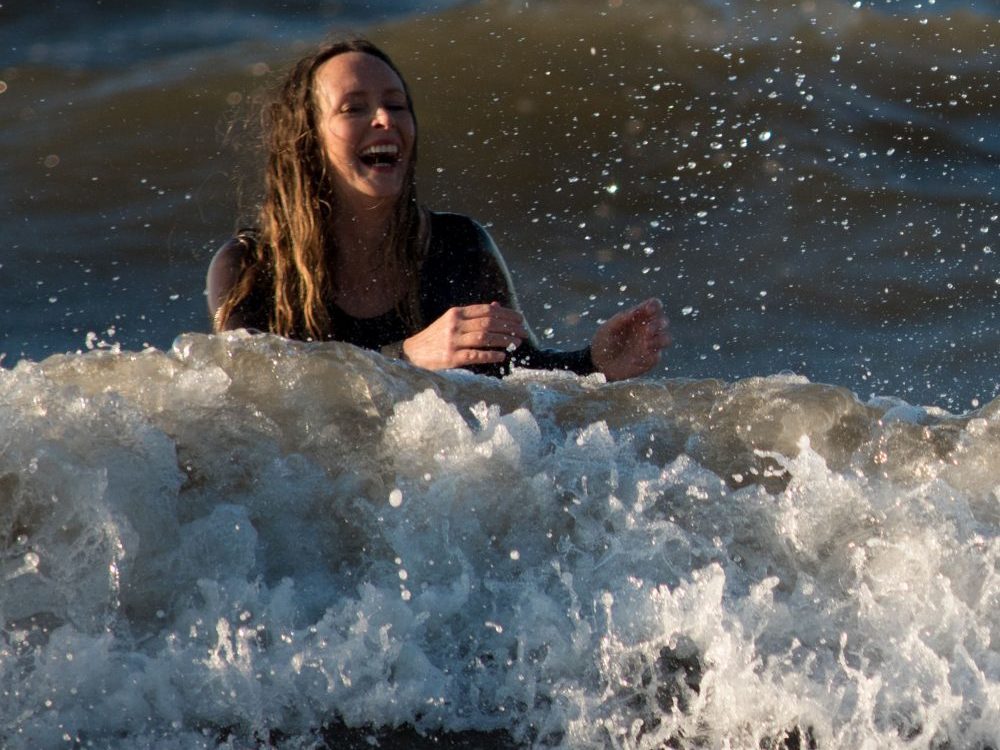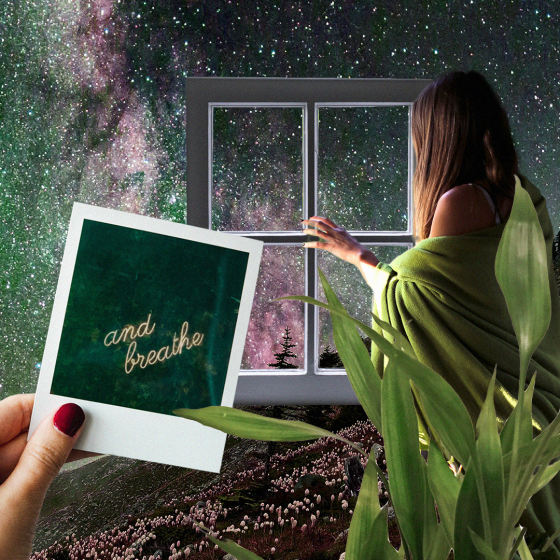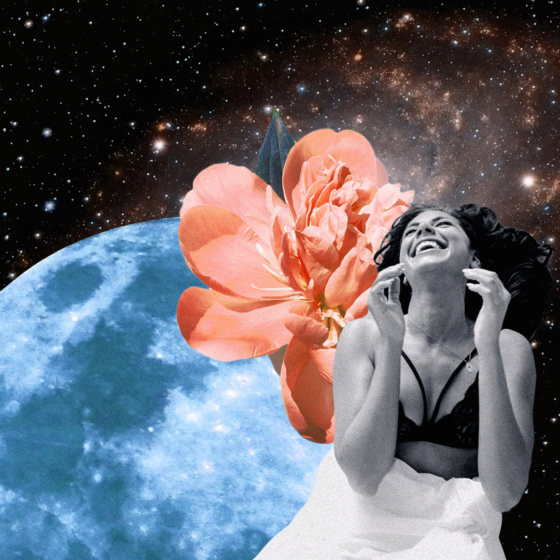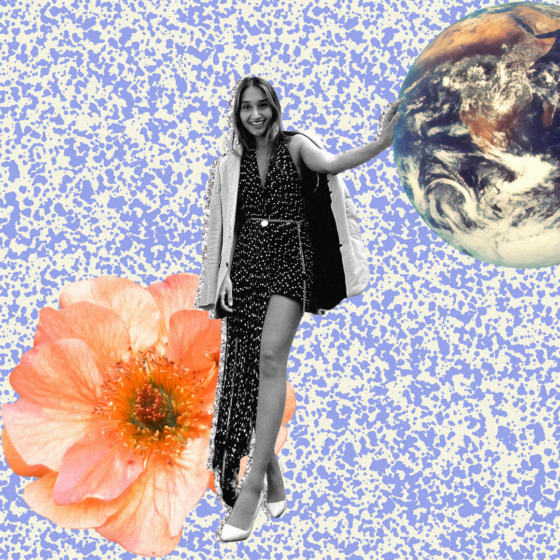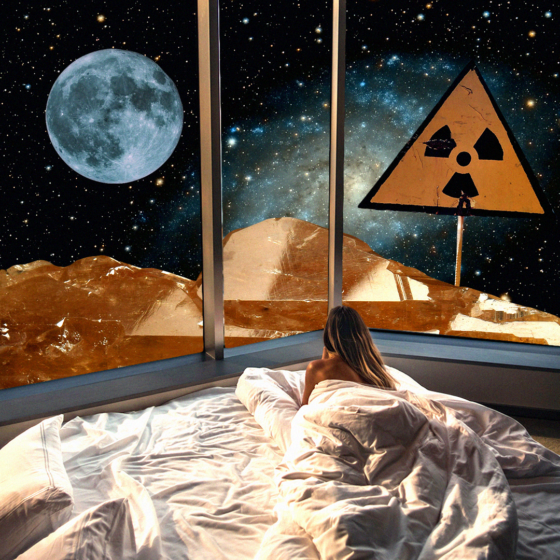When professional photographer Anna Deacon decided to take her camera along on her sea swims off the coast of Scotland, her aim was to take a break from the freelance work that was leaving her burnt out. In fact, what resulted was a project that would completely overhaul her professional life – and her understanding of mental health, body confidence and female solidarity to boot.

The photographs in the book feature swimmers taking the plunge in freezing water all over Scotland. What did you find had led your subjects to wild swimming?
The most common, overriding reason is probably mental health – anxiety and depression in particular. A lot of people swim because of pain conditions too, because it’s really good for inflammation. But I would say mental health is probably the biggest issue I came across, and the loneliness that comes from that struggle. Finding people to swim with, finding a hobby and a reason to be outdoors, was really helping a lot of the people I met.
What was your own reason for taking it up, and have you noticed an impact on your own wellbeing?
I struggle a lot with joint pain, and I’ve really noticed it helps a lot with that. I get sciatica, in my hands in particular, and there have been times where I’ve struggled to work because my hands were so sore. I couldn’t really operate a camera, or even drive a car at times, because my hands just wouldn’t work correctly. I found cold water swimming really helped bring my inflammation down, and that was a revelation. And of course, once I started getting so much from it, I just kept going. But I think I also use it as a sort of reset button, which is something you often hear other swimmers talking about. It’s a definite reset, and I always feel a sense of elation on my way home.
Is that what you think hooks people into wild swimming?
I think you definitely get an adrenaline buzz from it. You get a real sense that you’ve done something epic, even though you perhaps haven’t gone that far from home. It’s a bit like when you go on a rollercoaster – you have that nervous feeling when you get on but when you get off, you’re all giddy and excited and you want to do it again. That’s the only thing I could liken it to. It’s that anticipation of doing something a bit mad and exciting and scary, and then the joy and excitement you feel once you’ve done it. I think most people looking in think it’s a bit of an eccentric pastime, but then they try it themselves and they see there’s far more to it.

I feel there’s a sense of empowerment as well from doing something that, from the outside, looks a little bit crazy…
Absolutely, you feel amazing afterwards, like She-Ra! But you do think ‘If I can do this, I can do anything.’ There are definitely times in my life where I doubt myself. But now I can think ‘Well, I’ve smashed ice and swum in a frozen loch, and most people wouldn’t do that, so if I can do that, I can do this. This is fine.’
Are there any of the pictures, or the people’s stories, that have particularly resonated or stuck with you?
Honestly, there are so many. Everyone I’ve met has had an interesting story, even those who think they don’t. But there is one particular lady called Jackie who has only two per cent vision but loch swims regularly with a guide. I found her so inspiring, because she is scared of deep water and she can’t see where she’s going or how deep it is. She has to absolutely rely on her guide to tell her where she’s going and that it’s ok, and I found that so inspirational. I’m someone who has a bit of a fear of the deep, and I’m quite a worry wart. But to see her tackle it with such confidence really just makes me think that if she can do it, anyone can.
I was one of 70 women to join you for a swim on International Women’s Day earlier this year, alongside everyone from doctors and lawyers, to athletes and even a peace negotiator. Is that variety something you’ve seen replicated throughout the project?
Absolutely. I’ve swum with people who span nearly a hundred years between them, from age four to over 90. We’ve met the most extraordinary mix of men, women and children, both able-bodied and disabled, and that’s one thing that people keep saying to me after seeing the book. There is no type, and there’s someone everyone can relate to within those pages. And I think that just goes to show how inclusive it is a pastime.

What struck me about your work is that body image almost doesn’t seem to come into it. Would that be fair to say, and why do you think that is?
I think because you’re so in the moment, the issue of body confidence, or lack of it, hardly registers. At a swimming pool, you almost have to make an entrance to the room, and I find that really hard. I get very, very self-conscious. But for some reason, on the beach, in the cold, when everyone is focussed on the swim, you’re not really thinking at all about what you look like. You’re thinking about how your body feels – is it too cold, are you getting dry quickly enough, what’s the air temperature, can I feel my hands? You’re not thinking about whether your cellulite is showing or whether you’ve tended to your bikini line, you’re thinking ‘yay, I’m still alive!’ You’re too busy marvelling at the amazing things your body can do to worry what it looks like. Obviously, there are things I would change about my body when I look in the mirror, and I wouldn’t call myself body confident in any way. But I have found a confidence in my body, in what it can do and where it can take me, through wild swimming. That said, I’m very conscious of the fact that photographing people in their swimsuits is a soul-baring moment. You’re telling me stories about your life while wearing very few clothes – that’s a big thing to trust me with and I feel that trust very heavily.

There’s an image in the book of a group of people skinny dipping in the North Sea and it’s an absolute joy. How did that come about?
Earlier this year, I’d taken a picture of a couple of girls I swim with regularly who didn’t necessarily want to be recognised, but really wanted to do a skinny dip picture. They both have body confidence issues and I think they felt it would be quite an empowering thing to do. So, we went to this wild, quiet beach and it was literally frozen solid and we had this wild swim and did the picture, then I chucked off my own swimsuit and joined in with them and it was hilarious. It felt great and we had so much fun. Then, when it came to pulling together images for the book, I felt we needed another skinny dip picture, so I put a call out on our local swim group saying we were going to do a sunrise skinny dip and loads of people signed up. I was so surprised at the level of interest.
And was everyone just confidently getting naked?
Amazingly, a number of the people who came along admitted no-one had seen them naked for years. They felt compelled to do it, but they couldn’t really explain why, and I realised there were a lot of people there who felt desperately self-conscious. So, everyone arrived feeling quite shy and unsure of how to start. Then one woman took all her clothes off and started striding confidently towards the water, and this kind of weird silence took over as everyone else took their clothes off and walked towards the water together. I don’t think anyone expected it to happen like that, but it was such an empowering moment. A number of people asked me to do individual pictures of them after the group shot – they now have them hanging on their walls at home – and then we all sat around a fire and ate cake. It was a quite extraordinary morning.
What do you now think it was that compelled those people to take part?
I think because it’s like wild swimming, but up a level, a feeling of challenging yourself further. And for a lot of people, it is about acceptance and body positivity, about doing something that challenges every fear they have about their body and who they are. There’s something really, really powerful about that.
What do you feel the project has taught you about today’s women and how they’re travelling through life?
I think it’s made me realise that I am not alone in feeling anxiety and a lot of pressure. Most women that I’ve spoken to feel exactly the same, that they’re spinning plates and constantly at risk of dropping them. For a lot of those women, wild swimming is a form of self-care – it might be the only thing that they’re doing to look after themselves, but it’s something that makes them feel alive and powerful. Many of us are mothers, we’re taking care of small people all the time, prioritising others, always giving and not putting anything back in. So while swimming might only take up a tiny bit of our weeks, it’s a way of putting back in, of investing time in ourselves, and I think that’s really important. It’s made me realise that in taking on something that’s just for yourself, whether it’s swimming or it’s something else, you’re filling yourself back up so that you can be whole again.
Why do you think it has such appeal to busy working women?
I think sometimes packing a gym bag and going to a class can feel like a bit of an effort, or an investment of more time than you have. But you can’t swim for long in cold water. You can be in and out in no time at all and really feel like you’ve done something epic in that little window. And then, even if the rest of your day goes to shit, you’ve done something amazing and you’ll sleep like a baby afterwards. You can live off that feeling for a couple of days I find.
How important is the element of camaraderie?
I find that when you’re swimming along with someone in that moment, you do find that you share more than you might if you were just having a glass of wine in the pub or something. Perhaps because you’re doing something that makes you feel empowered, or perhaps because you’re relaxed or in the moment? I find a lot of secrets are shared and tears are spilled in the water, and you always leave feeling lighter than you went in.
There’s also a meditative aspect to it, isn’t there? That biting cold makes you focus on your breath and your body in a way that some people might struggle with when it comes to standard meditation…
Oh, absolutely. I can’t meditate, I’m far too busy-minded, but when I’m walking into the water, I’m completely and utterly in that moment. I can’t be going through my shopping list in my head or worrying about tomorrow because I’m too busy thinking about whether I can feel my toes, whether there are rocks underfoot, where the tide is going and what the weather is doing. I am completely and utterly focussed on what I’m doing. And even when I’m swimming with others, we’re all in that same moment, doing that together. So even when you’re not alone, it is very much a process of mindfulness. We have a whole chapter on that aspect of it in the book, because it is huge.
Has your work in the water impacted on your wider photography, in the sense that you look at your subjects differently now?
I definitely find traditional portraiture harder now in a way. In the past, my role would have been very much as an observer, but through doing this, I’ve become an active participant in the process. I think it makes it a lot easier to see that real essence of a person. But it’s given me the courage to do something a bit different, to not play things so safe with my photography. I took a risk with something and it’s paid off, and that’s been really impactful for me.
If you had to sum the book up, what would that summary sound like? Because it’s not, strictly speaking, a book about swimming…
No, it’s not. It’s a book about people. About people’s stories. The subtitle is The Healing Power of Swimming for Mind, Body and Soul and we thought long and hard about that, because that’s really what it’s about. It’s about all those elements of you, and how this can fit in with that, no matter who you are and what you do.
Can you imagine a life now where you don’t throw yourself in the sea regularly?
No, not at all. I might cool it down a bit, given I’ve been in eight or nine times a week sometimes during this project! But I couldn’t be without it, and if I could go every day and really make it work, I absolutely would. But I suspect I’ll settle for two or three times a week…
Taking The Plunge: The Healing Power of Wild Swimming for Mind, Body & Soul by Anna Deacon & Vicky Allan, published by Black & White Publishing, will be available at all good bookshops from November 7, priced at £20. Order your copy here.

